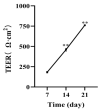Effects of 6-Shogaol on Glucose Uptake and Intestinal Barrier Integrity in Caco-2 Cells
- PMID: 36766032
- PMCID: PMC9913893
- DOI: 10.3390/foods12030503
Effects of 6-Shogaol on Glucose Uptake and Intestinal Barrier Integrity in Caco-2 Cells
Abstract
As the main bioactive component in dried ginger, 6-shogaol has potential hypoglycemic activity, but its mechanism is still unclear. The process of carbohydrate digestion and glucose absorption is closely related to the enzymatic activity of epithelial brush cells, expression of glucose transporters, and permeability of intestinal epithelial cells. Therefore, this study explored the hypoglycemic mechanism of 6-shogaol from the perspective of glucose uptake, absorption transport, and protection of intestinal barrier function. Based on molecular docking, the binding energy of 6-shogaol and α-glucosidase is -6.24 kcal/mol, showing a high binding affinity. Moreover, a-glucosidase enzymatic activity was reduced (-78.96%) when the 6-shogaol concentration was 500 µg/mL. After 6-shogaol intervention, the glucose uptake was reduced; the relative expression of glucose transporters GLUT2 and SGLT1 were down regulated; and tight junction proteins ZO-1, Occludin and Claudin were up regulated in differentiated Caco-2 cells. This study confirmed that 6-shogaol effectively inhibits the activity of α-glucosidase and has beneficial effects on glucose uptake, protection of intestinal barrier function, and promotion of intestinal material absorption.
Keywords: 6-shogaol; Caco-2 cells; barrier function; glucose uptake.
Conflict of interest statement
The authors declare no conflict of interest.
Figures






Similar articles
-
Antidiabetic potential of Lysiphyllum strychnifolium (Craib) A. Schmitz compounds in human intestinal epithelial Caco-2 cells and molecular docking-based approaches.BMC Complement Med Ther. 2022 Sep 5;22(1):235. doi: 10.1186/s12906-022-03706-x. BMC Complement Med Ther. 2022. PMID: 36064352 Free PMC article.
-
Yogurt inhibits intestinal barrier dysfunction in Caco-2 cells by increasing tight junctions.Food Funct. 2017 Jan 25;8(1):406-414. doi: 10.1039/c6fo01592a. Food Funct. 2017. PMID: 28091645
-
Inhibitory effect of black tea and its combination with acarbose on small intestinal α-glucosidase activity.J Ethnopharmacol. 2015 Feb 23;161:147-55. doi: 10.1016/j.jep.2014.12.009. Epub 2014 Dec 16. J Ethnopharmacol. 2015. PMID: 25523370
-
Daidzein Protects Caco-2 Cells against Lipopolysaccharide-Induced Intestinal Epithelial Barrier Injury by Suppressing PI3K/AKT and P38 Pathways.Molecules. 2022 Dec 15;27(24):8928. doi: 10.3390/molecules27248928. Molecules. 2022. PMID: 36558058 Free PMC article.
-
Transport, metabolism and remedial potential of functional food extracts (FFEs) in Caco-2 cells monolayer: A review.Food Res Int. 2020 Oct;136:109240. doi: 10.1016/j.foodres.2020.109240. Epub 2020 Apr 16. Food Res Int. 2020. PMID: 32846508 Review.
Cited by
-
Evaluation of Quality Parameters and Functional Activity of Ottobratica Extra Virgin Olive Oil Enriched with Zingiber officinale (Ginger) by Two Different Enrichment Processes during One-Year Storage.Foods. 2023 Oct 18;12(20):3822. doi: 10.3390/foods12203822. Foods. 2023. PMID: 37893715 Free PMC article.
-
The impact of combined thymol and rosmarinic acid on the intestinal microbiota and barrier function of the piglets challenged by Escherichia coli K88.Anim Nutr. 2024 Dec 3;20:131-144. doi: 10.1016/j.aninu.2024.11.008. eCollection 2025 Mar. Anim Nutr. 2024. PMID: 39967693 Free PMC article.
-
In vitro α-Glucosidase Inhibition, Cytotoxicity, SAR, Swiss ADME Prediction and Molecular Docking Study of New N-Substituted Hydantoin Derivatives.ChemistryOpen. 2025 Apr;14(4):e202400119. doi: 10.1002/open.202400119. Epub 2025 Feb 3. ChemistryOpen. 2025. PMID: 39901517 Free PMC article.
-
Thermosensitive hydrogel with emodin-loaded triple-targeted nanoparticles for a rectal drug delivery system in the treatment of chronic non-bacterial prostatitis.J Nanobiotechnology. 2024 Jan 18;22(1):33. doi: 10.1186/s12951-023-02282-7. J Nanobiotechnology. 2024. PMID: 38238760 Free PMC article.
References
-
- Osae R., Apaliya M.T., Kwaw E., Chisepo M.T.R., Antiri E.A., Yarley O.P.N., Alolga R.N. Antioxidant activities, anti-inflammatory, cytotoxic effects, quality attributes, and bioactive compounds of ghanaian ginger under varied dehydration conditions. J. Food Process. Preserv. 2021;45:e15994. doi: 10.1111/jfpp.15994. - DOI
-
- Tinello F., Zannoni S., Lante A. Antioxidant properties of soybean oil supplemented with ginger and turmeric powders. Appl. Sci. 2020;10:8438. doi: 10.3390/app10238438. - DOI
Grants and funding
LinkOut - more resources
Full Text Sources
Research Materials

